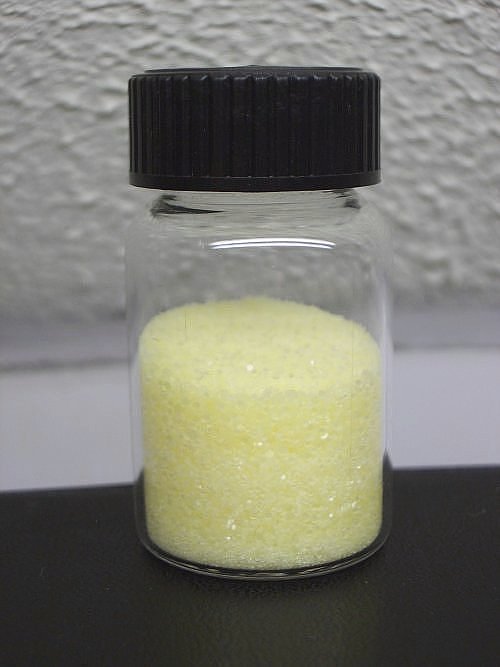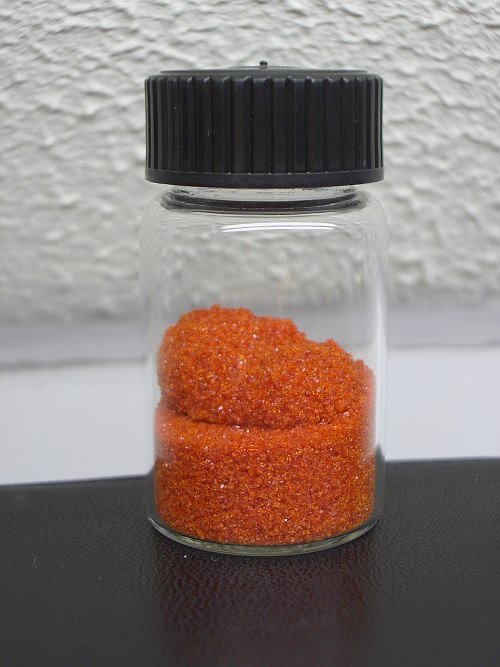


Colorful precipitates with hexacyanoferrate
Hexacyanoferrate exists in two forms, the hexacyanoferrate (II) and the hexacyanoferrate (III). The potassium salts of these two ions are called yellow prussiate of potash and red prussiate of potash, more modern names are potassium ferrocyanide and potassium ferricyanide.
The ions are Fe(CN)64- and Fe(CN)63-. The solid salts are yellow and red. Solutions of the ferrocyanide are light yellow and solutions of ferricyanide are intense yellow. Below follow pictures of the two solid salts and their solutions:


<TOEVOEGEN FOTO's VAN OPLOSSINGEN>
Here, precipitates of many metals with these two salts are shown. It is remarkable how colorful precipitates with these ions are. The bright colors of these precipitates are exploited in photography quite a lot in a whole class of toners, the so-called metal/ferrocyanide toners.
![]()
![]() Required
chemicals:
Required
chemicals:
-
potassium ferrocyanide (potassium hexacyanoferrate (II))
-
potassium ferricyanide (potassium hexacyanoferrate (III))
-
hydrochloric acid
- hydrogen peroxide, 3%.
-
titanium
-
... <VERDER INVULLEN>
![]() Required
equipment:
Required
equipment:
-
test tubes
![]() Safety:
Safety:
- Regard all chemicals in this experiment as toxic.
- Hydrochloric acid is corrosive and the concentrated acid gives off pungent fumes.
- If potassium hexacyanoferrate (either the yellow or the red salt) is mixed with concentrated acid, then some hydrogen cyanide may be released. There is a certain risk for this, although the cyanide-ligands are connected to the iron-core very tightly. Just to be on the safe side, do not mix the salts and the precipitates with concentrated acids.
![]() Disposal:
Disposal:
- Waste of all transition metals, except titanium, iron, manganese and zinc must be brought to a proper waste processing facility. All other waste can be flushed down the drain with a lot of water.
- The hexacyanoferrates are not particularly toxic in spite of their cyanide content and as long as quantities do not exceed a few hundreds of mg and as long as they are not contaminated with other toxic metals, they may be flushed down the drain with a lot of water.
![]()
Precipitates of titanium (III)
A solution of a titanium (III) salt can be prepared by adding some titanium metal to concentrated hydrochloric acid. This produces a deep blue/purple solution, as described here. Dilute this deep blue/purple solution three times with water. Now a purple solution is obtained, which contains sufficient titanium (III) ions and is not too concentrated with respect to acidity.
This purple solution of titanium (III) is mixed with ferricyanide and ferrocyanide. The picture below shows both precipitates, the ferricyanide at the left and the ferrocyanide at the right. Probably, the left test tube contains an oxidized species, where titanium is oxidized to the +4 oxidation state and the ferricyanide is reduced, but as will be shown later on, precipitates of hexacyanoferrate can have very unexpected colors.

When part of the precipitate is added to an excess amount of dilute hydrogen peroxide (3%), then the result is as follows:

The result of this is even more remarkable. The brown precipitate of titanium (III) with the ferricyanide turns red/orange with a red/brown precipitate. This can be expected to some extent, because of the formation of the red peroxo-complex of titanium (IV). The yellow/brown/orange precipitate of titanium (III) with ferrocyanide turns dark green. Apparently, no free titanium (IV) can be produced, resulting in the deep red peroxo-complex, but something is oxidized, but not to the reddish brown material in the left test tube. This cannot be explained easily. Why isn't all material oxidized to a state, comparable to that in the left test tube. Apparently titanium (III) ferrocyanide resists full oxidation by hydrogen peroxide.